 |
Turning to the State administration,
with a mean score of 52%, there is a noticeably negative result for written
communications, where surprsingly only 11% of written communications are realised in
Catalan, which means that this administration neither issues documents nor holds,
practically speaking, models of documents in Catalan for the local population. The
situation for signs and labels in central government offices —both for identification
purposes [RID] and informational purposes [RIN]— is less than bilingual On the other
hand, the oral language tips slightly in favour of Catalan in self-identification [LOI,
55%] and clearly does so in adapting to the language of a caller who expresses himself /
herself in Catalan [LOC, 70%].
Figure 3.
State administration
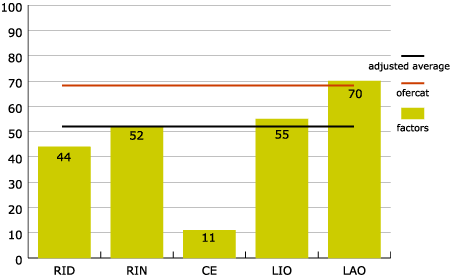
Justice and
the law courts constitute rather a special case (no pun intended) because the transference
of competences to the Generalitat was subsequent to 1983 and was not total, since in
certain fundamental aspects it continues to be subject to state directives. This can be
seen in the way signs and labels or identification purposes tend to be bilingual [RID,
57%] while informational signs are more Catalanicised [RIN, 65%]. The strongest point of
the Justice administration is the availability of models of documents in Catalan for the
general public and the staff in this ambit [WRC, 75%], the result of the work of language
normalisation technicians of the Department of Justice in recent years who have translated
these models. That does not mean, however, that the paper work, rulings and verdicts, the
judicial documents in the widest sense, are in the Catalan language. The weak point of
Justice is the oral language factor: 23% in identification [LOI] and 30% in the
convergence on the caller's Catalan [LOC]. This almost certainly reflects the fact of
staffing and mobility: gaining of posts of responsibility by means of competition is still
organised by central government in Madrid.
Figure
4. Justice
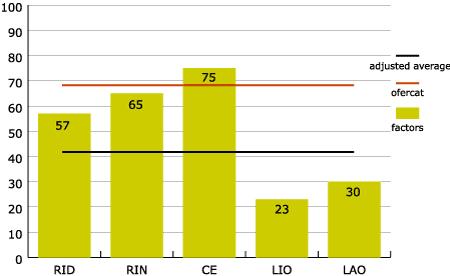
6. The provision of Catalan in the economy and society sectors
The Economy
sector includes companies in the primary and secondary sectors in the factory estates,
hypermarkets and shopping centres, as well as professional and trades associations, public
transport, shops and services. Each of these subsectors (and the ambits in which they are
divided) present indicators that are quite differentiated depending on the factors. The
overall mean score or index is 66% for provision of Catalan, where the language of oral
convergence has considerable weight [LOC, 75%]. Less favourably, there is the factor of
written communications [WRC 55%], where considerable skewing comes from the advertising
leaflets dropped into letterboxes, so here Tarragona barely scrapes a bilingual score.
Signs and labels, both the identification and the informational, attain 60%.
Figure
5. Economy
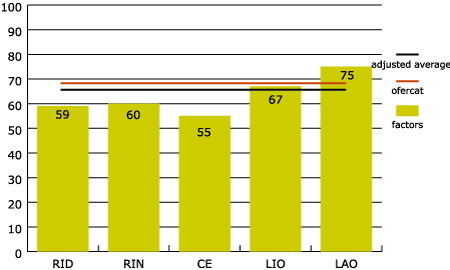
Also a
separate study was made of the signs and notices in the centre of the city and the
suburbs. In this case the differences are notable: the percentages we find in the city
centre reach 80% (RID) and 72% (RIN), while in the Tarragona suburbs percentages dip as
low as 54% (RID) and 23% (RIN). The signs and notices, of course, are a reflection of the
sociolinguistic contrasts of the city.
Figure
6. Shop and service companies (neighborhood)
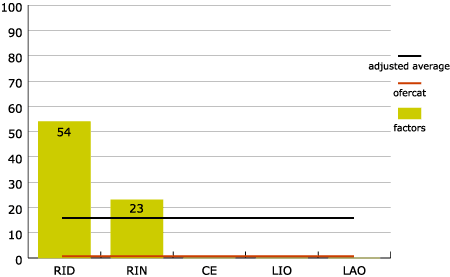
Figure
7. Shop and service companies (town centre)
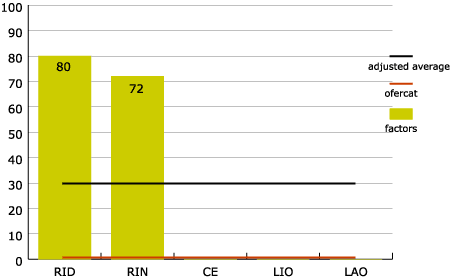
The Society and leisure
sections include cultural and sports associations of all kinds, Christian parishes and
churches, cinema, theatre and sports events. All factors are around 80%, except the
language of oral identification [LIO] which scores 50%. The reason, in large part, for
this discrepancy lies in the language used in the films —100% in Spanish, whether
dubbed or direct— at the time the observations were made. To a lesser extent, it is
also the result of the language use of the cultural and sports associations, although in
this case the situation is notable compensated by the language of Oral Convergence, that
is, the degree of Oral Convergence on the caller's Catalan [LOC], which reached 89%.
Figure
8. Society and leisure
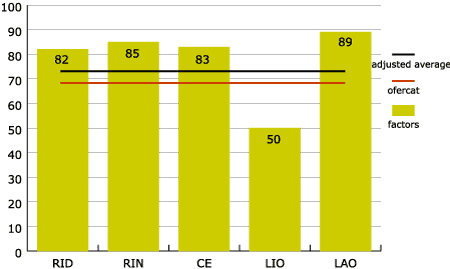
7. The provision of Catalan in the media and health and education
In the case of
the Media only two factors are observed: firstly, written communication [WRC], in other
words, the daily and weekly papers, with both local and county-wide distribution, as well
as the papers and magazines with general distribution; and secondly the language of oral
identification [LOI], that is to say, the audio-visual media —radio stations and TV
networks—here too with local and county distribution as we as general distribution.
Thus, both in one case and the other, the mean score is at around 40% Catalan. Where the
press is concerned, this (in any case not very high) result is due to the local papers and
the two general dailies in Catalan. Turning to the audio-visual media, there are local
television stations and the Autonomous regional television (Catalonia), as well as local
television stations and the local programming of the nationwide networks, all making a
contribution to this result.
Figure
9. Media
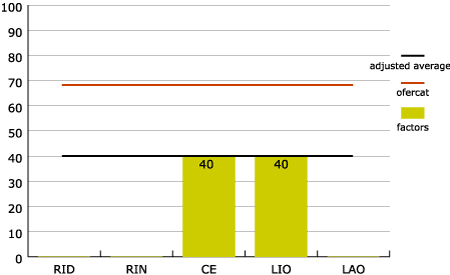
|
